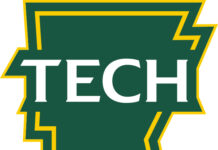th anniversary, many former and present faculty, staff and students have shared their thoughts on the campus’ changes over the past decade. One such person is Ken Warden, Ed.D., chief business and community outreach officer, who first started working for the campus in 1997 as chair of the automotive technology service department. On July 1, 2003, Arkansas Valley Technical Institute merged with Arkansas Tech University to form Arkansas Tech-Ozark. A formal celebration of the anniversary is slated for Tuesday, Sept. 10, at Arkansas Tech-Ozark. Warden, who also served as business and industry coordinator from 2006-09, when he was named the campus’ first chief business and community outreach coordinator, said the greatest differences are the increases in enrollment and degree offerings. Before the merger, AVTI enrolled around 300 students and offered 12 technical certificates. Arkansas Tech-Ozark now offers 11 associate degrees and 15 technical certificates. For the fall 2012 semester, it saw an enrollment of 2,033 students. “We are the premier option for career technical education in the region and offer some options that you cannot find at most two-year schools,” he said. Such programs include viticulture, enology, cardiovascular technology, occupational therapy assistant, physical therapist assistant, health information technology and human resources. A large part of the campus’ academic advancement has been the addition of general education courses, which he said are a “tremendous asset.” Also, because of the merger all accredited coursework is transferable. “This improved our capacity to serve our students by increasing access to advanced educational opportunity in the region.” Asked what he believes makes Arkansas Tech-Ozark unique, Warden said, “I have personally been involved with five higher education institutions in the state, either as a student or an employee. What sets us apart is our dedication to student success. “We meet our students where they are and work to increase their educational attainment to make them more employable and increase their earning potential and upward mobility. It’s our mission, and we work to this mission in an attitude of service and respect for our students. “This doesn’t just happen episodically or in one area. We practice with these principles every day in all aspects of our school, from student services, to faculty instruction, to business services, to community outreach. “Many institutions talk about mission. We live it.”
–30–
]]>




